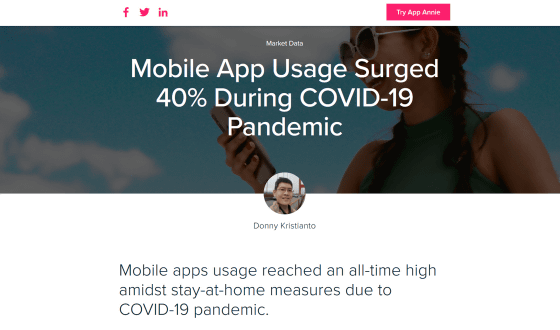It turned out that the use of mobile applications has increased dramatically all over the world during the pandemic of the new coronavirus

In order to prevent the spread of new coronavirus infectious disease (COVID-19), countries around the world have been banned and forced to change their lifestyles. Meanwhile,
Mobile App Usage Surged 40% During COVID-19 Pandemic
https://www.appannie.com/en/insights/market-data/mobile-app-usage-surged-40-during-covid-19-pandemic/

Consumers spent $17 billion through the App Store in Q2 of 2020 | iMore
Many countries have implemented strategies to maintain social distances due to the impact of the COVID-19 pandemic, schools are closed and moved to online classes, and companies that have introduced remote work are also significant. increased. According to App Annie, in the second quarter of 2020 (April-June), mobile app usage time increased by 40% compared to the same period last year, and in April 2020, the total monthly mobile app usage worldwide It is said that the usage time exceeded 200 billion hours and set a record high.

Mobile app spending in India increased 35% in the second quarter of 2020 compared to the fourth quarter of 2019, 30% in Italy, 25% in Indonesia and 15% in the US. App Annie points out that the exponential growth in mobile app usage in each country is being driven by lifestyle changes to address COVID-19.
COVID-19 is still on the rise in India, Russia, and Brazil, but in countries such as China and South Korea, the pandemic of COVID-19 is recovering, and mobile app developers have eased their social distance strategy. After that, it is necessary to think about how to attract users.
In the second quarter of 2020, new downloaded mobile apps reached a record high of 35 billion, of which 25 billion were Android apps and 10 billion were iOS apps. The number of new downloads for Android apps increased 10% year-on-year, and the number of new downloads for iOS apps increased 20% year-on-year. The ratio of game applications to newly downloaded mobile applications was about 45% for Android applications and about 30% for iOS applications.

The impact of the COVID-19 pandemic can be seen not only from the overall usage time and the number of downloads, but also from the category of the downloaded application. Compared to the first quarter of 2020, Google Play has seen 115% more apps in the business category, 75% more apps in the health and fitness category, and 50% more apps in the education category, with more downloads. In the App Store, 30% of apps in the Health & Fitness category, 25% of apps in the Shopping category, and 20% of apps in the Medical category have increased downloads compared to the first quarter.
It is said that the apps that increased the number of downloads in the second quarter of 2020 were useful for health management while waiting at home and online shopping, and were often used for remote work and online lectures. App Annie's examples include collaboration tools
From the left, the images below show the apps with the most downloads, the apps with the most sales, and the apps with the most active users in the second quarter of 2020. Looking at the apps with the most downloads, you can see that the downloads of ZOOM Cloud Meetings, Google Meet, etc. have increased significantly from the previous period. According to App Annie, these apps are used not only for business and education, but also for artists performing live online.

Also, in the second quarter of 2020, not only usage time and downloads, but also the amount of money users spent on the app reached a record high. Consumer spending on iOS apps increased 15% year-on-year to $17 billion (about 1.8 trillion yen), and Android apps recorded 25% year-on-year increase to $10 billion (about 1.7 trillion yen). That. Of these, game apps accounted for approximately 75% of sales for iOS apps and 85% for Android apps. The countries that have contributed the most to consumer spending are 'America and Japan' on both iOS and Android, and we can see that many have billed mobile apps during the COVID-19 pandemic.

App Annie said, “The new coronavirus pandemic has revolutionized the way consumers and businesses interact. Today, the average mobile user spends 4 hours and 20 minutes a day on smartphones, a successful mobile experience. It's more important than ever for a brand to develop a strategy to do that,” he said, arguing that mobile apps are becoming very important.

Related Posts:
in Software, Smartphone, Posted by log1h_ik







